| Family: |
Leuciscidae (Minnows), subfamily: Pogonichthyinae |
| Max. size: |
7 cm TL (male/unsexed) |
| Environment: |
demersal; freshwater |
| Distribution: |
North America: Willamette River drainages in Oregon, USA. |
| Diagnosis: |
Anal soft rays: 7-7. Oregonichthys crameri can be distinguished by the following characters: caudal peduncle strongly tapering to very narrow; barbel small (sometimes absent) at corner of terminal mouth; rounded snout; dorsal-fin origin over or slightly behind pelvic-fin origin; breast fully scaled; lateral line complete with 35-39 scales; 7 anal-fin rays; pharyngeal teeth 1,4-4,1; body compressed and deepest at dorsal-fin origin; and color consists of olive-tan above, green-brown stripe along back in front of dorsal fin, clusters of large brown-black spots scattered over back and silver side giving salt-and -pepper appearance, darkly outlined scales on back, lines of brown specks on lower side (Ref. 86798). |
| Biology: |
Occurs in sluggish sand- and gravel-bottomed pools and backwaters of creeks and small rivers. Often found in vegetation and sometimes in ponds and impoundments (Ref. 86798). |
| IUCN Red List Status: |
Least Concern (LC); Date assessed: 18 April 2012 Ref. (130435)
|
| Threat to humans: |
harmless |
Source and more info: www.fishbase.org. For personal, classroom, and other internal use only. Not for publication.

